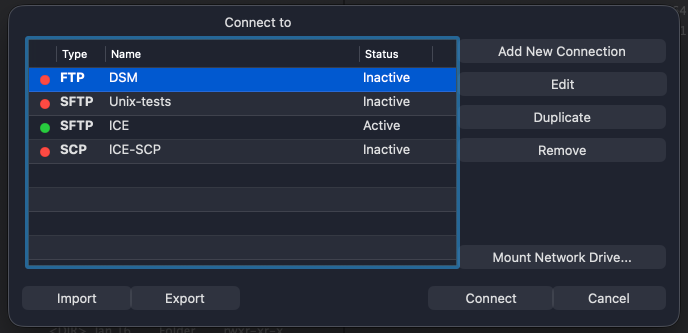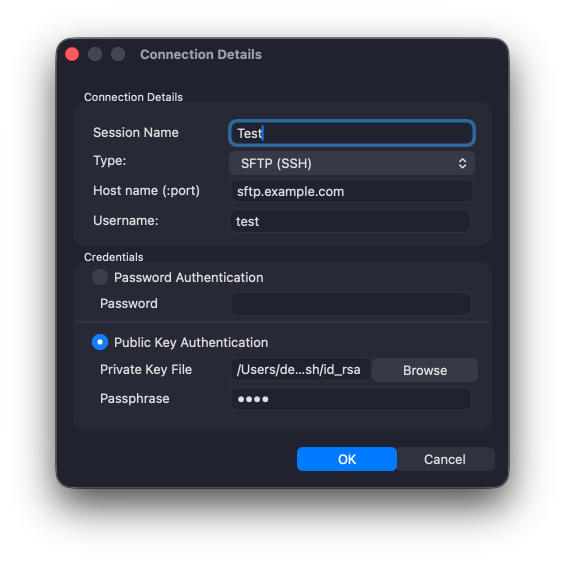Remote Connections
Use Connection Manager to manage server sessions and network shares. The window shows your saved sessions, lets you Add / Edit / Duplicate / Remove, Import / Export all sessions, Mount Network Drive (SMB/AFP), and Connect/Disconnect the selected entry.
The Connection Manager window

- Saved connections list — three columns:
- Type:
FTP,SFTP, orSCP - Name: your session name
- Status:
InactiveorActive
- Type:
- Buttons:
- Add new connection
- Edit, Duplicate, Remove (operate on the selected entry)
- Import, Export (backup/restore all saved connections)
- Mount Network Drive (SMB/AFP — not saved here)
- Connect / Disconnect (toggles based on status)
- Cancel (closes the window)
Double-click a saved connection to Connect. When connected, Status becomes Active and the Connect button changes to Disconnect.
Add a new saved connection (FTP/SFTP/SCP)
Click Add new connection and fill in:

- Session Name — how it appears in the list
- Type —
FTP,SFTP, orSCP - Hostname — DNS/IP, you may append
:port(e.g.,example.com:2222) - Username
- Authentication
- Password Auth — enter the password
- Public Key Auth — choose Key file and (if needed) Passphrase
Press OK to save. The session now appears in the list and can be connected later.
To adjust later:
- Edit — change any field
- Duplicate — clone and tweak (useful for staging vs production)
- Remove — delete the saved entry
Import / Export
- Export writes all saved connections to a file (for backup or moving to another Mac).
- Import restores from that file.
Connect and disconnect
- Select a saved entry and click Connect (or double-click it).
- On success:
- Status shows Active
- Connect becomes Disconnect
- Click Disconnect to end the session.
The connected location appears in DCommander for browsing and file operations just like any other location.
Mount a Network Drive (SMB/AFP)
Click Mount Network Drive for Windows/NAS/older macOS shares. This is separate from saved FTP/SFTP/SCP sessions and is not stored in the saved list.

Fill in:
- Protocol —
SMBorAFP - Hostname or IP
- Username and Password
- Remote folder / share
As you type, the Full network path auto-builds, e.g.:
smb://username:password@server/share
Click Connect to mount the network drive. Once mounted, it appears like any other drive in DCommander.
SMB/AFP mounts are temporary system mounts and aren’t saved as Connection Manager entries.
Working with connected remotes
- Browse directories, view files and copy/move as usual.
- Direction is always active pane → inactive pane (tap Tab to switch).
Troubleshooting
- Auth fails / cannot connect — Re-check Hostname (and
:port), Username, and auth type (Password vs Public Key). Try Edit to correct, then reconnect. - Status doesn’t change to Active — Connection likely didn’t complete; review credentials and server reachability, then try again.
- SMB path looks wrong — Confirm Hostname, Remote folder, and that the Full network path matches your environment (e.g.,
smb://user@server/share). - Don’t see the mounted share — Ensure it mounted successfully and that you have permissions to list the share; refresh the pane.
Related
- First-run Setup — Permissions for protected paths
- File Operations — Transfer manager and progress